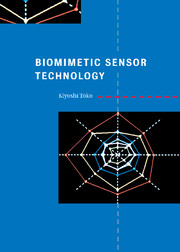8 - Toward a sensor to reproduce human senses
Published online by Cambridge University Press: 23 October 2009
Summary
Discrimination of wine flavor using taste and odor sensors
Earlier chapters have reviewed a range of sensor types. Recently, there have been striking developments in odor and taste sensors. As shown in Fig. 8.1, it may not be impossible to discuss deliciousness of foods by combining the sensors corresponding to the five senses. We can use an optical sensor for the color, a thermometer for the temperature, a pressure sensor for the texture, a taste sensor for the taste and an odor sensor for the odor. Analysis of outputs from the above sensors, together with environmental and personal information, may lead to quantification of deliciousness. The following example describes a first step of this trial.
Wine has both taste and odor qualities resulting from different aromatic molecules in the liquid and vapor phases. The average wine contains about 80–85% water and over 500 different substances, some of which are very important to the wine flavor in spite of their low concentrations. The main groups are acids, alcohols, esters, sugars and tannins. The difference in the color of wine comes mainly from tannins (which are also responsible for the flavor). The tannins are present in the solid part of the grapes, which are fermented together with the liquid part when a red wine is made; for white wines only the liquid from grapes is used.
- Type
- Chapter
- Information
- Biomimetic Sensor Technology , pp. 196 - 208Publisher: Cambridge University PressPrint publication year: 2000



